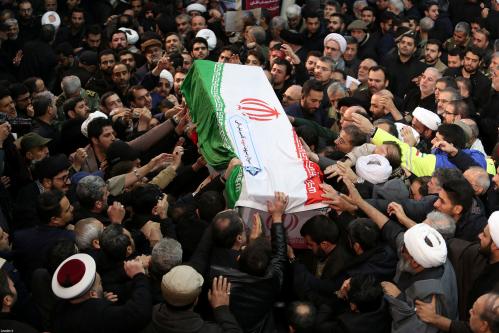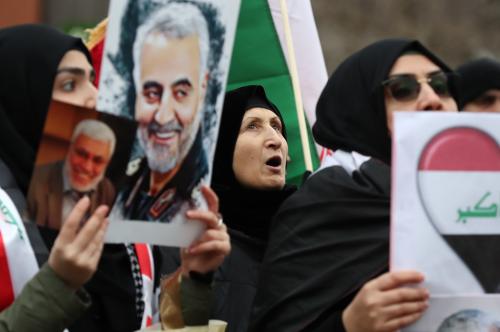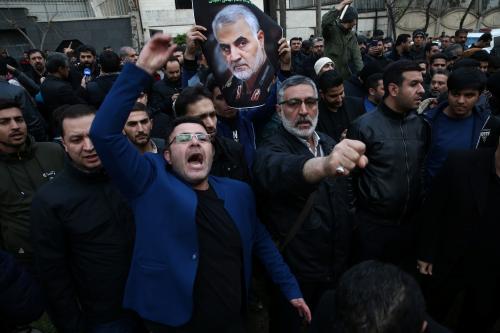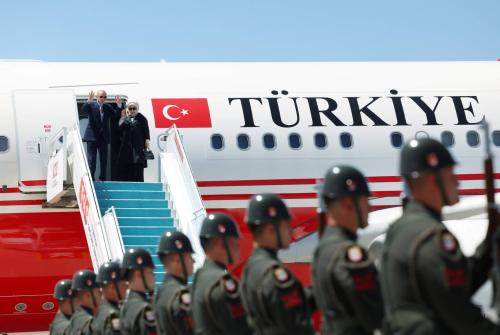The recent killing of Qassem Soleimani, head of Iran’s Islamic Revolutionary Guard Corps Quds Force, further undermines the United States’ already weak position in the Middle East, writes Daniel Byman. This piece originally appeared in Vox.
The U.S. drone strike that killed Maj. Gen. Qassem Soleimani, the long-time leader of Iran’s paramilitary Quds Force of the Islamic Republican Guard Corps, comes when the United States is at a dangerous crossroads in the Middle East. Soleimani was responsible for many of Iran’s most important relationships, including with paramilitary groups in Iraq, the Lebanese militant group Hezbollah, and Palestinian terrorist groups like Hamas, among many others. In many countries, he and the Quds Force basically controlled Iranian policy.
By killing him, the United States is risking a major escalation with Iran and across the region at a time when the overall U.S. position is weak and growing weaker. Tehran has vowed “harsh revenge” and declared it is withdrawing from the nuclear deal in its entirety. Trump, for his part, has tweeted out yet more threats, vowing to “HIT VERY FAST AND VERY HARD.”
….targeted 52 Iranian sites (representing the 52 American hostages taken by Iran many years ago), some at a very high level & important to Iran & the Iranian culture, and those targets, and Iran itself, WILL BE HIT VERY FAST AND VERY HARD. The USA wants no more threats!
— Donald J. Trump (@realDonaldTrump) January 4, 2020
With painful irony, Trump is escalating tensions with Iran just as he is weakening the overall U.S. position in the Middle East. His actions may force a U.S. withdrawal from Iraq, hinder the fight against ISIS, and bolster hardliners in Tehran — all while making American allies uncertain and fearful.
A reconsideration is in order, but the Trump administration has no record of such self-scrutiny. Rather, its record in the region so far is confusing and ineffectual. As a result, the influence of U.S. adversaries like Iran is likely to grow, while allies will, by necessity, go their own ways.
Soleimani’s death comes when Iran’s position in the Middle East is vulnerable. Recent months have seen popular protests in Iran, Iraq, and Lebanon, with hundreds dying in government crackdowns. Most of the protesters focused on corruption, the poor quality of government services, and other bread-and-butter issues. However, a strong theme throughout the protests in Iraq and Lebanon was resentment at Iran’s undue influence in these countries and the manipulation of politics. In Iran itself, protests swept more than 100 cities, and demonstrators burned revolutionary leaders in effigy.
Iran’s increasing influence in Iraq, Syria, and Yemen has alarmed many of the region’s Sunni powers. In addition, the public in Iraq and Lebanon were expressing unhappiness with Tehran’s influence in their domestic politics. Politically, the situation was ripe for pushing back. However, the dominant regional story now is the Soleimani killing, Iran’s potential response, and the risk of broader escalation. Even before the assassination, U.S. strikes in Iraq last month against the Iranian-backed Kata’ib Hezbollah militant group enabled Iran’s allies there to portray the United States as the aggressor and shifted the discourse to one of “resistance” against American imperialism, a timely diversion for Iran.
Tehran used its allies in Iraq to orchestrate demonstrations at the U.S. embassy in Baghdad, burning parts of the compound: just enough violence to threaten the United States, but not enough to provoke U.S. military retaliation. That was incorrect, as it turned out. Tehran’s leaders probably thought that their limited use of violence would lead Trump, who in the past was highly cautious about a confrontation with Iran, to step back — a clear misjudgment of a mercurial leader.
The strike that killed Soleimani also killed several leaders of Iraqi militant groups, further inflaming the situation. Following these deaths, the gloves are likely to come off, allowing Tehran to shift the discourse both at home and in Iraq to questions of vengeance and supposed U.S. aggression rather than the Iranian regime’s own abuses and declining popularity. Already, Iraqi leaders and the country’s parliament are calling for the withdrawal of U.S. troops from Iraq, though it is unclear if this proposal will move forward.
Even as the Trump administration prepares for an Iranian response, U.S. allies continue to work at cross-purposes in the absence of American leadership or even basic guidance.
Trump has abandoned allies and sent conflicting messages across the region
The rift between Qatar on one side, and Saudi Arabia and the United Arab Emirates on another, still divides key U.S. Gulf allies, all of whose support would be vital in a broader military confrontation with Tehran. They disagree primarily on whether or not to support Islamists in the Middle East’s many crises, and Trump has egged them on rather than try to calm tempers.
In Libya, allies are on opposite sides of the country’s messy civil war. Turkey has announced it will deploy troops to back up its growing military support for the U.S.- and U.N.-recognized Government of National Accord (GNA) in Tripoli. Saudi Arabia and the UAE, other important regional allies, are backing a rival force led by Khalifa Haftar, a Libyan general opposed to Islamists. Which thuggish claimants to power are better for Libya and its fractured political scene is an open question, but the Trump administration’s approach has been the worst. The United States formally recognizes the GNA, but Trump himself has praised Haftar, sending a confusing signal. In any event, a proxy war involving important U.S. allies increases regional instability and distracts them from Iran and other dangers.
Allies are understandably nervous, as President Trump has made no secret of his desire to end the U.S. military presence in the Middle East. “We’re getting out. Let someone else fight over this long blood-stained sand. The job of our military is not to police the world,” he declared.
Even countries like Saudi Arabia and Israel that were critical of Obama and welcomed Trump’s victory are reconsidering their relations with the United States. For these and other U.S. allies, the U.S. presence has been an extra layer of security. However, Trump’s decision not to respond when Iranian drones attacked Saudi oil facilities and temporarily disrupted half the country’s oil production (roughly 5% of global output) changed the calculus of what constituted a traditional “red line.” Trump made it clear that threats to allied security are no longer important for the United States.
Now allies are preparing to go their own way; Riyadh has even made overtures to Tehran, though it is likely to back away while the risk of a greater U.S.-Iran conflict is high. Saudi Arabia wants the United States to take a strong stand against Iran politically, but its leaders worry that they will get caught in the crossfire if the shooting war escalates.
Nature abhors a vacuum
Not surprisingly, others are stepping into the void created by the weak and confusing U.S. position. Russia, in particular, is stepping up its role. Fresh from helping the Assad regime secure victory in the Syrian civil war, Russian aid and mercenaries have made Haftar’s forces in Libya even more formidable. Even staunch U.S. allies like Israel are now courting Moscow as an important regional actor. Iran, long a pariah, held joint naval exercises with Russia and China just before the latest round of conflict began.
All these problems might be forgivable if they followed a broader logic and reflected a considered decision to reduce the U.S. role in the region and, therefore, try to achieve less.
However, the Trump administration remains as long on ambitious policy declarations as it is short on commitment. Nowhere has this been more clear than with Iran.
Under Trump, the administration withdrew from the Joint Comprehensive Plan of Action (JCPOA), the Iranian nuclear deal that the president has described as “one of the worst and most one-sided transactions the United States has ever entered into.” Subsequently, the United States embarked on a campaign of “maximum pressure” against Iran, and indeed, the increased sanctions and financial pressure have hit Tehran hard. Iran has now declared it will not abide by the nuclear deal, though it has refrained from saying it will take the next steps to build a bomb.
However, it is not clear what, exactly, the United States seeks from Tehran, as the Trump administration has never laid out a realistic set of goals.
Trump claims not to want regime change, but his administration has never laid out a serious negotiating position detailing its goals. After the Soleimani killing, any such talks will be off indefinitely. Moreover, by drawing down forces in Syria, not responding to Iran’s attack on Saudi Arabia, and railing against a military presence in general, U.S. leverage with allies and adversaries alike has decreased. Similarly, the administration has failed to rally U.S. regional allies around a common strategy, instead letting them get sidetracked in Syria (and now, Libya) into fighting each other. By killing Soleimani, the United States has upped the stakes dramatically, but it has done so at a time when allies are angry and confused and U.S. goals are unclear.
The future looks grim, as neither Iran nor the United States is pulling back. Iran is widely expected to retaliate for the death of its iconic military leader. Trump’s threats against Iran and the additional attacks on pro-Iran militant groups in Iraq, as well as threats to sanction Iraq if it tells American forces to leave, make it seem that the United States wants to escalate the situation. Iran may try to hit American bases and troops, diplomatic facilities, or even the U.S. homeland. The large number of U.S. military outposts and official facilities give it plenty of locations to target.
Trump has used limited force in the Middle East before, such as his one-off strike against Syria for its use of chemical weapons, or continuing the Obama administration’s campaign against ISIS. In taking on Iran, however, the consequences are far more grave. Iran is far more capable of projecting violence abroad than Syria or ISIS, and it has more tools to punch back. In addition, Trump acted with the support of U.S. allies in previous cases, whereas this time most allies are hesitant, believing the United States escalated without good reason.
What a reasonable, strategic administration would do
As the likelihood of a confrontation with Iran grows, it would be an opportune time for the United States to take stock of its position in the Middle East and determine its realistic goals there.
Another administration, say that of George W. Bush or Barack Obama, would quickly prioritize U.S. goals and determine the price the country would pay to achieve them. This could either involve trying to deescalate the situation by continuing to support a low-level troop presence or even reducing it further. Or it might mean preparing for a greater confrontation, courting allies to win their support while sending an array of forces to the region and coordinating with Saudi Arabia, Turkey, and other countries currently at odds. It could also mean recognizing that alienating Iraq and making Iran even more of an enemy hinders the fight against ISIS.
Such careful thinking is unlikely during Trump’s time in office. Unfortunately, it is more likely that this administration will move from crisis to crisis, from tweet to tweet, without developing an overall game plan. In so doing, it will be caught flat-footed each time with the wrong size force and without the necessary allies.
Under another administration, there might even be long-term advantages to the Soleimani killing. It’s possible to imagine after an additional round or two of attacks, a mix of coercion and inducements could bring Iran back to the negotiating table on conditions more favorable to the United States. Doing so, however, would require a clear strategic vision and ability to bring allies together around it — plus a willingness to shift the U.S. regional posture to back up both threats and diplomacy. Trump’s record suggests none of these conditions are likely.
Nor will the U.S. position vis-a-vis Iran necessarily improve significantly should Trump lose the 2020 election. A new administration cannot set the clock back to the pre-Trump era, and Iran’s vengeance is going to be against the United States, not any particular administration. The connections that regional states are forging to Russia, and the disruption among traditional allies, cannot be easily remedied. Indeed, Trump has greatly weakened the U.S. position. Having skill, resources, and dedication would no doubt help a future administration, but the hole Trump has dug is deep and growing deeper.
The Brookings Institution is committed to quality, independence, and impact.
We are supported by a diverse array of funders. In line with our values and policies, each Brookings publication represents the sole views of its author(s).









Commentary
Trump’s reckless Middle East policy has brought the US to the brink of war
January 6, 2020